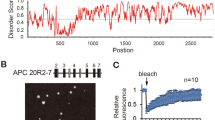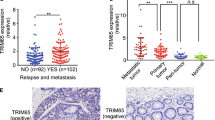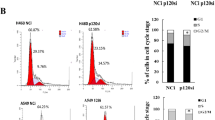Abstract
The adenomatous polyposis coli (APC) tumor suppressor is a nucleocytoplasmic protein. The nuclear accumulation of APC was recently found to vary depending on cell density, suggesting that putative APC function(s) in the nucleus is controlled by the establishment of cell contacts. We report here that the density-dependent redistribution of APC between nucleus and cytoplasm prevails in 6/6 thyroid and colorectal carcinoma cell lines. Moreover, mutated APC lacking known nuclear localization sequences had the similar distribution pattern as the full-length protein. APC invariably accumulated in the nuclei of Ki-67 expressing cells, but was largely cytoplasmic when cell cycle exit was induced by serum starvation or at high cell density. APC colocalized with β-catenin in the nucleus only in one cell line (SW480). Also, APC maintained a predominantly nuclear position in early confluent states when cytoplasmic β-catenin was recruited to newly formed adherens-like junctions. The results indicate that nuclear targeting of APC is driven by cell cycle entry rather than altered cell–cell contact. The ability of C-terminally truncated APC to accumulate in the nucleus suggests that nuclear import signals other than NLS1APC and NLS2APC are functionally important. Residual function(s) of N-terminal APC fragments in tumor cells carrying APC mutations might be beneficial to tumor growth and survival.
This is a preview of subscription content, access via your institution
Access options
Subscribe to this journal
Receive 50 print issues and online access
$259.00 per year
only $5.18 per issue
Buy this article
- Purchase on Springer Link
- Instant access to full article PDF
Prices may be subject to local taxes which are calculated during checkout








Similar content being viewed by others
References
Ahmed K, Gerber DA and Cochet C . (2002). Trends Cell Biol., 12, 226–230.
Baeg GH, Matsumine A, Kuroda T, Bhattacharjee RN, Miyashiro I, Toyoshima K and Akiyama T . (1995). EMBO J., 14, 5618–5625.
Bienz M . (2002). Nat. Rev. Mol. Cell. Biol., 3, 328–338.
Brocardo MG, Bianchini M, Radrizzani M, Reyes GB, Dugour AV, Taminelli GL, Gonzalez Solveyra C and Santa-Coloma TA . (2001). Biochem. Biophys. Res. Commun., 284, 982–986.
Cetta F, Olschwang S, Petracci M, Montalto G, Baldi C, Zuckermann M, Costantini RM and Fusco A . (1998). World J. Surg., 22, 1231–1236.
Deka J, Herter P, Sprenger-Haussels M, Koosch S, Franz D, Muller KM, Kuhnen C, Hoffmann I and Muller O . (1999). Oncogene., 18, 5654–5661.
Eleftheriou A, Yoshida M and Henderson BR . (2001). J. Biol. Chem., 276, 25883–25888.
Fagotto F, Gluck U and Gumbiner BM . (1998). Curr. Biol., 8, 181–190.
Fearnhead NS, Britton MP and Bodmer WF . (2001). Hum. Mol. Genet., 10, 721–733.
Fodde R, Kuipers J, Rosenberg C, Smits R, Kielman M, Gaspar C, van Es JH, Breukel C, Wiegant J, Giles RH and Clevers H . (2001a). Nat. Cell. Biol., 3, 433–438.
Fodde R, Smits R and Clevers H . (2001b). Nat. Rev. Cancer, 1, 55–67.
Galea MA, Eleftheriou A and Henderson BR . (2001). J. Biol. Chem., 276, 45833–45839.
Gerdes J, Lemke H, Baisch H, Wacker HH, Schwab U and Stein H . (1984). J. Immunol., 133, 1710–1715.
Hamada F and Bienz M . (2002). Nat. Cell Biol., 4, 208–213.
He TC, Sparks AB, Rago C, Hermeking H, Zawel L, da Costa LT, Morin PJ, Vogelstein B and Kinzler KW . (1998). Science, 281, 1509–1512.
Henderson BR . (2000). Nat. Cell Biol., 2, 653–660.
Henderson BR and Fagotto F . (2002). EMBO Rep., 3, 834–839.
Homma MK, Li D, Krebs EG, Yuasa Y and Homma Y . (2002). Proc. Natl. Acad. Sci. USA, 99, 5959–5964.
Hulsken J, Birchmeier W and Behrens J . (1994). J. Cell Biol., 127, 2061–2069.
Ilyas M, Tomlinson IP, Rowan A, Pignatelli M and Bodmer WF . (1997). Proc. Natl. Acad. Sci. USA, 94, 10330–10334.
Ishidate T, Matsumine A, Toyoshima K and Akiyama T . (2000). Oncogene., 19, 365–372.
Kaplan KB, Burds AA, Swedlow JR, Bekir SS, Sorger PK and Nathke IS . (2001). Nat. Cell Biol., 3, 429–432.
Kinzler KW, Nilbert MC, Su LK, Vogelstein B, Bryan TM, Levy DB, Smith KJ, Preisinger AC, Hedge P, McKechnie D, Finniear R, Markham A, Groffen J, Boguski MS, Altschul SF, Horii A, Ando H, Miyoshi Y, Miki Y, Nishisho I and Nakamura Y . (1991). Science, 253, 661–665.
Korinek V, Barker N, Morin PJ, van Wichen D, de Weger R, Kinzler KW, Vogelstein B and Clevers H . (1997). Science, 275, 1784–1787.
Mann B, Gelos M, Siedow A, Hanski ML, Gratchev A, Ilyas M, Bodmer WF, Moyer MP, Riecken EO, Buhr HJ and Hanski C . (1999). Proc. Natl. Acad. Sci. USA, 96, 1603–1608.
Miyoshi Y, Nagase H, Ando H, Horii A, Ichii S, Nakatsuru S, Aoki T, Miki Y, Mori T and Nakamura Y . (1992). Hum. Mol. Genet., 1, 229–233.
Mogensen MM, Tucker JB, Mackie JB, Prescott AR and Nathke IS . (2002). J. Cell Biol., 157, 1041–1048.
Morin PJ, Sparks AB, Korinek V, Barker N, Clevers H, Vogelstein B and Kinzler KW . (1997). Science, 275, 1787–1790.
Munemitsu S, Albert I, Souza B, Rubinfeld B and Polakis P . (1995). Proc. Natl. Acad. Sci. USA, 92, 3046–3050.
Munemitsu S, Souza B, Muller O, Albert I, Rubinfeld B and Polakis P . (1994). Cancer Res., 54, 3676–3681.
Nathke IS, Adams CL, Polakis P, Sellin JH and Nelson WJ . (1996). J. Cell Biol., 134, 165–179.
Neufeld KL, Nix DA, Bogerd H, Kang Y, Beckerle MC, Cullen BR and White RL . (2000a). Proc. Natl. Acad. Sci. USA, 97, 12085–12090.
Neufeld KL and White RL . (1997). Proc. Natl. Acad. Sci. USA, 94, 3034–3039.
Neufeld KL, Zhang F, Cullen BR and White RL . (2000b). EMBO Rep., 1, 519–523.
Nishisho I, Nakamura Y, Miyoshi Y, Miki Y, Ando H, Horii A, Koyama K, Utsunomiya J, Baba S, Hedge P, Markham A, Krush AJ, Petersen G, Hamilton SR, Nilbert MC, Levy DB, Bryan TM, Preisinger AC, Smith KJ, Su LK, Kinzler KW and Vogelstein B . (1991). Science, 253, 665–669.
Prosser J, Condie A, Wright M, Horn JM, Fantes JA, Wyllie AH and Dunlop MG . (1994). Br. J. Cancer, 70, 841–846.
Rosin-Arbesfeld R, Townsley F and Bienz M . (2000). Nature, 406, 1009–1012.
Rowan AJ, Lamlum H, Ilyas M, Wheeler J, Straub J, Papadopoulou A, Bicknell D, Bodmer WF and Tomlinson IP . (2000). Proc. Natl. Acad. Sci. USA, 97, 3352–3557.
Rubinfeld B, Robbins P, El-Gamil M, Albert I, Porfiri E and Polakis P . (1997). Science, 275, 1790–1792.
Rubinfeld B, Souza B, Albert I, Muller O, Chamberlain SH, Masiarz FR, Munemitsu S and Polakis P . (1993). Science, 262, 1731–1734.
Schonthal AH . (2001). Cancer Lett., 170, 1–13.
Seeling JM, Miller JR, Gil R, Moon RT, White R and Virshup DM . (1999). Science, 283, 2089–2091.
Senda T, Miyashiro I, Matsumine A, Baeg GH, Monden T, Kobayashil S, Monden M, Toyoshima K and Akiyama T . (1996). Biochem. Biophys. Res. Commun., 223, 329–334.
Sieber OM, Tomlinson IP and Lamlum H . (2000). Mol. Med. Today, 6, 462–469.
Smith KJ, Johnson KA, Bryan TM, Hill DE, Markowitz S, Willson JK, Paraskeva C, Petersen GM, Hamilton SR, Vogelstein B and Kinzler KW . (1993). Proc. Natl. Acad. Sci. USA, 90, 2846–2850.
Smith KJ, Levy DB, Maupin P, Pollard TD, Vogelstein B and Kinzler KW . (1994). Cancer Res., 54, 3672–3675.
Su LK, Burrell M, Hill DE, Gyuris J, Brent R, Wiltshire R, Trent J, Vogelstein B and Kinzler KW . (1995). Cancer Res., 55, 2972–2977.
Su LK, Vogelstein B and Kinzler KW . (1993). Science, 262, 1734–1737.
van der Luijt RB, Khan PM, Vasen HF, Tops CM, van Leeuwen-Cornelisse IS, Wijnen JT, van der Klift HM, Plug RJ, Griffioen G and Fodde R . (1997). Hum. Mutat., 9, 7–16.
Wiechens N and Fagotto F . (2001). Curr. Biol., 11, 18–27.
Zhang F, White RL and Neufeld KL . (2000). Proc. Natl. Acad. Sci. USA, 97, 12577–12582.
Zhang F, White RL and Neufeld KL . (2001). Mol. Cell. Biol., 21, 8143–8156.
Acknowledgements
We are grateful to Dr Inke Näthke, Dundee, UK for generously sharing the APC antiserum, Dr Nils-Erik Heldin for providing the cell lines, Professor Keiko Funa for sharing FACS equipment, Mats Grände and other members of the Nilsson/Ericson lab for valuable discussions and to Therese Carlsson for technical assistance. This work was supported by grants from The Swedish Research Council (12X-537), The Assar Gabrielsson Foundation for Clinical Research, The Magnus Bergwall Foundation and by The Royal Swedish Academy of Sciences.
Author information
Authors and Affiliations
Corresponding author
Rights and permissions
About this article
Cite this article
Fagman, H., Larsson, F., Arvidsson, Y. et al. Nuclear accumulation of full-length and truncated adenomatous polyposis coli protein in tumor cells depends on proliferation. Oncogene 22, 6013–6022 (2003). https://doi.org/10.1038/sj.onc.1206731
Received:
Revised:
Accepted:
Published:
Issue Date:
DOI: https://doi.org/10.1038/sj.onc.1206731
Keywords
This article is cited by
-
Validation and application of a novel APC antibody in western blotting, immunoprecipitation, and immunohistochemistry
Medical Molecular Morphology (2018)
-
Multi-scale modeling of APC and \(\beta \)β-catenin regulation in the human colonic crypt
Journal of Mathematical Biology (2018)
-
A knock-in mouse model reveals roles for nuclear Apc in cell proliferation, Wnt signal inhibition and tumor suppression
Oncogene (2012)
-
TCF-3, 4 protein expression correlates with β-catenin expression in MSS and MSI-H colorectal cancer from HNPCC patients but not in sporadic colorectal cancers
International Journal of Colorectal Disease (2010)
-
Truncation mutations abolish chromatin-associated activities of adenomatous polyposis coli
Oncogene (2008)



